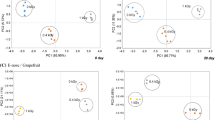Abstract
Photostimulated luminescence (PSL) or thermo-luminescence (TL) analysis and electron spin resonance (ESR) spectroscopy were performed to detect radiation-induced markers in various trading fruits, such as oranges, grapefruits, mandarins, lemons, limes, bananas, and pineapples. All the unknown samples were identified as non-irradiated fruits, and gamma irradiation at 1 kGy permitted dose by Codex and US FDA was applied to investigate radiation-induced markers. The photon counts for all calibrated PSL samples revealed higher than 5000 (positive) except banana. The ESR triplet signals were detected as a radiation-induced marker resulting from cellulose existing in irradiated fruits excluding banana. The unambiguous identification of irradiated banana was impossible by both techniques. However, isolated minerals from all fruit samples showed radiation-induced typical TL glow curves through the normalization step, confirming the feasible application of TL analysis for identifying irradiation status of all the subjected trading fruits.



Similar content being viewed by others
References
Bortolin E, Boniglia C, Calicchia A, Alberti A, Fuochi P, Onori S (2007) Irradiated herbs and spices detection: light-induced fading of the photo-stimulated luminescence response. Int J Food Sci Tech 42:330–335
Bustos-Griffin E, Hallman GJ, Griffin RL (2012) Current and potential trade in horticultural products irradiated for phytosanitary purposes. Radiat Phys Chem 81:1203–1207
D’Oca MC, Bartolotta A (2010) The identification of irradiated crustaceans and evaluation of the dose by thermoluminescence: intercomparison between two methods for extracting minerals. Food Res Int 43:1255–1259
Desrosiers MF, McLaughlin WL (1989) Examination of gamma-irradiated fruits and vegetables by electron spin resonance spectroscopy. Int J Radiat Appl Instrum C Radiat Phys Chem 34:895–898
Diehl JF (2002) Food irradiation–past, present and future. Radiat Phys Chem 63:211–215
Elahi S, Straub I, Thurlow K, Farnell P, Walker M (2008) Referee analysis of suspected irradiated food. Food Control 19:269–277
EN13751 (2009) Foodstuffs − detection of irradiated food using photostimulated luminescence. European Committee of Standardization, Belgium
EN1787 (2001) Foodstuffs − detection of irradiated food containing cellulose by ESR spectroscopy. European Committee of Standardization, Belgium
EN1788 (2001) Foodstuffs − thermoluminescence detection of irradiated food from which silicate minerals can be isolated. Methods by Thermoluminescence. European Committee of Standardization, Belgium
Hallman GJ (2011) Phytosanitary applications of irradiation. Compr Rev Food Sci F 10:143–151
IAEA (2014) International atomic energy agency homepage. http://nucleus.iaea.org. Accessed 12 Dec 2014
Jo D, Kwon JH (2006) Detection of radiation-induced markers from parts of irradiated kiwifruits. Food Control 17:617–621
Jo D, Kim BK, Kausar T, Kwon JH (2008) Study of photostimulated- and thermo-luminescence characteristics for detecting irradiated kiwifruit. J Agr Food Chem 56:1180–1183
Kyung HK, Ahn JJ, Akram K, Kwon JH (2012) Thermoluminescence analysis of irradiated dried sea foods using different methods of mineral separation. Radiat Phys Chem 81:1224–1226
Lagunas-Solar MC (1995) Radiation processing of foods: an overview of scientific principles and current status. J Food Protect 58:186–192
Marchesani G, Mangiacotti M, Chiaravalle AE (2012) Identifying irradiated oysters by luminescence techniques (TL & PSL). Food Chem 135:319–324
Okello JJ, Narrod C, Roy D (2007) Food safety requirements in African green bean exports and their impact on small farmers. IFPRI Discussion Paper 00737, International Food Policy Research Institute. http://www.ifpri.org/publication/food-safety-requirements-african-green-bean-exports-and-their-impact-small-farmers. Accessed 14 June 2014
Polónia I, Esteves MP, Andrade ME, Empis J (1995) Identification of irradiated peppers by electron spin resonance, thermoluminescence and viscosity. Radiat Phys Chem 46:757–760
Polovka M, Brezova V, Stasko A, Mazur M, Suhaj M, Simko P (2006) EPR investigation of gamma-irradiated ground black pepper. Radiat Phys Chem 75:309–321
Roberts D (1998) Preliminary assessment of the effects of the WTO agreement on sanitary and phyto-sanitary trade regulations. J Int Econ Law 1:377–405
Sanderson DCW, Carmichael LA, Fisk S (2003) Photostimulated luminescence detection of irradiated herbs, spices, and seasonings: international interlaboratory trial. J AOAC Int 86:990–997
Sanyal B, Sharma A (2009) New electron paramagnetic resonance method to identify irradiated soybean. J Food Sci 74:N57–N64
Sanyal B, Chawla SP, Sharma A (2011) An improved approach to identify irradiated dog feed by electron paramagnetic resonance study and thermoluminescence measurements. Radiat Phys Chem 80:650–657
Schreiber GA (1996) Thermo-luminescence and photo-stimulated luminescence techniques to identify irradiated foods. In: McMurray CH, Stewart EM, Gray R, Pearce J (eds) Detection methods for irradiated foods. The Royal Society of Chemistry, Cambridge, pp 121–123
Shahbaz HM, Akram K, Ahn JJ, Kwon JH (2013) Investigation of radiation induced free radicals and luminescence properties in fresh pomegranate fruits. J Agr Food Chem 61:4019–4025
Spotts RA, Cervantes LA (1986) Populations, pathogenicity and benomyl resistance of Botrytis spp., Penicillium spp. and Mucor piriformis in packinghouses. Plant Dis 70:106–108
Stanton GH, Wolff C (2008) Private voluntary standards and the world trade organization committee on sanitary and phyto-sanitary measures. Fresh Perspectives Series No. 16, DFID/IIED/NRI, http://www.agrifoodstandards.net. Accessed 14 June 2014
Stevenson MH, Stewart EM (1995) Identification of irradiated food: the current status. Radiat Phys Chem 46:653–658
Tabner BJ, Tabner VA (1991) An electron spin resonance study of gamma-irradiated grapes. Int J Radiat Appl Instrum C Radiat Phys Chem 38:523–531
USDA-APHIS (2006) Rules and Regulations, Treatments for fruits and vegetables. Federal Register 71: 4451–4564 http://docs.regulations.justia.com/entries/2006-01-27/06-746.pdf Accessed 7 Sept 2015
WHO (1999) High-Dose Irradiation: Wholesomeness of Food Irradiated with Doses above 10 kGy; Report of a Joint FAO/IAEA/WHO Study Group. WHO Technical Report Series 890, World Health Organization, Switzerland
Acknowledgments
This study was supported by the Export Promotion Technology Development Program, Ministry of Agriculture, Food and Rural Affairs, Republic of Korea.
Author information
Authors and Affiliations
Corresponding author
Rights and permissions
About this article
Cite this article
Jo, Y., Kyung, HK., Park, HJ. et al. Irradiated fruits can be identified by detecting radiation-induced markers with luminescence and ESR analyses for different trading fruits. Appl Biol Chem 59, 59–65 (2016). https://doi.org/10.1007/s13765-015-0132-9
Received:
Accepted:
Published:
Issue Date:
DOI: https://doi.org/10.1007/s13765-015-0132-9




